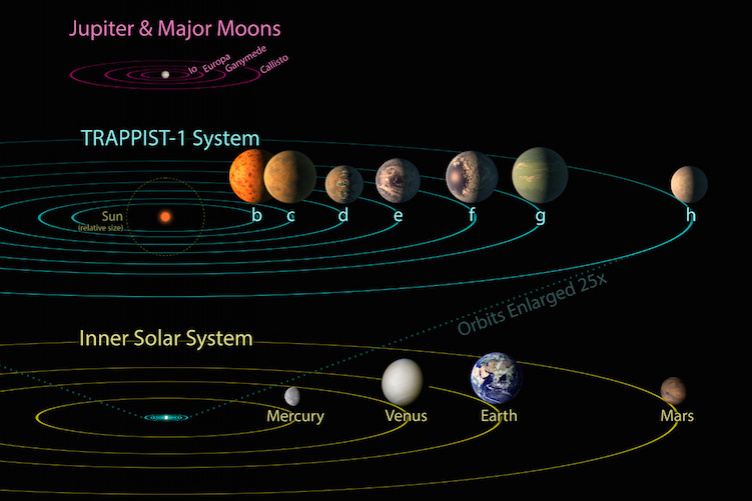
NASA image comparing TRAPPIST solar system. Courtesy photo
“Astronomy compels the soul to look upward and leads us from this world to another.”
—Plato, The Republic, 342 BCE
Last week, when NASA announced the discovery of seven new planets whose size and temperature indicate the possibility of life, Jody Wilson was, well, over the moon. Which is pretty much what you’d expect from a planetary scientist.
The seven planets are all orbiting the same ultracool dwarf star, TRAPPIST-1. Three of them are in what’s known as a habitable zone — an area of space whose conditions are best suited for life to form. Their distance from the star means they are temperate, not subjected to extremely hot or cold weather. Located in the constellation Aquarius, the exoplanets are 39 light-years away. (Refresher: The speed of light is 186,000 miles per second or 671 million miles per hour.)
“The idea is if a planet is too close to its star, water would boil away. And if it’s too far, like Pluto, water would freeze,” says Wilson, a researcher with UNH’s Space Science Center. “And if there is water, then the short answer to ‘could there be life?’ is absolutely.”
Even if that life is single-cell, he says.
“And if there is water, then the short answer to ‘could there be life?’ is absolutely.”
The TRAPPIST solar system, named for the Transiting Planets and Planetesimals Small Telescope that discovered it, represents the largest number of planets located in a habitable zone clustered around a single star outside Earth’s solar system. Three of the exoplanets were found in May 2016. All seven are about the size of Earth; the smallest is three-quarters of the size. Orbit durations range from one and a half days to 13 days. Changes in the brightness of the planets’ dwarf star helped astronomers figure out their size and orbit. Similar in size to Jupiter, TRAPPIST-1 is about 2,000 times fainter than the sun.
“If you look at the oldest rocks, as soon as Earth was cool enough to start forming them, we started having fossilized microbes. Of course, it took a half billion years. But for half of the history of life on Earth, there was single-cell life,” Wilson says. “If Earth is typical, then anywhere in the universe, you’re going to have microbes. As far as bigger animals go — well, that’s another question entirely.”
“Around the time we discovered there was something outside own solar system — as soon as we started thinking that way, we started to realize there are conditions supportive for life,” Wilson says. “If you think about our solar system, and the life forms at the bottom of the ocean, it’s a completely different ecosystem. Whatever happened on the surface of the Earth, they wouldn’t care; they’d keep on living. Now we realize, any planet or moon could have water and below the surface, if there's water there, there could be life."

But finding out if that’s true is about 800,000 years away, Wilson says. That’s how long it would take to reach the new solar system using the fastest spacecraft now available.
“TRAPPIST-1 is 39 light years away. The moon is one and half light-seconds away,” Wilson says. “So, we’re not going to find out if there’s life on these planets by going there — at least not any time soon — even though that’s the only way to be absolutely certain.”
Instead, scientists will have to rely on the next generation of telescopes. In 2018, NASA will launch the powerful infrared James Webb Space Telescope, a successor to the Hubble that will become the most powerful telescope ever built.
“Step one is having a big enough telescope. Step two would be to build a big radio and send a message,” Wilson says of searching for extraterrestrial life. “It would take 39 years to get there, and then, if we were listening, hopefully in 39 years, we’d get an answer back.”
Of discovering the rocky planets, Wilson says, “This is huge. The big question is, are we alone? Next: are there planets out there like ours? The first exoplanet was discovered 25 years ago. Today there are more than 3,500. So, yes, this is an incredible time to be alive.”
Interested in studying space science? UNH has a top-five program.
-
Written By:
Jody Record ’95 | Communications and Public Affairs | jody.record@unh.edu

















































